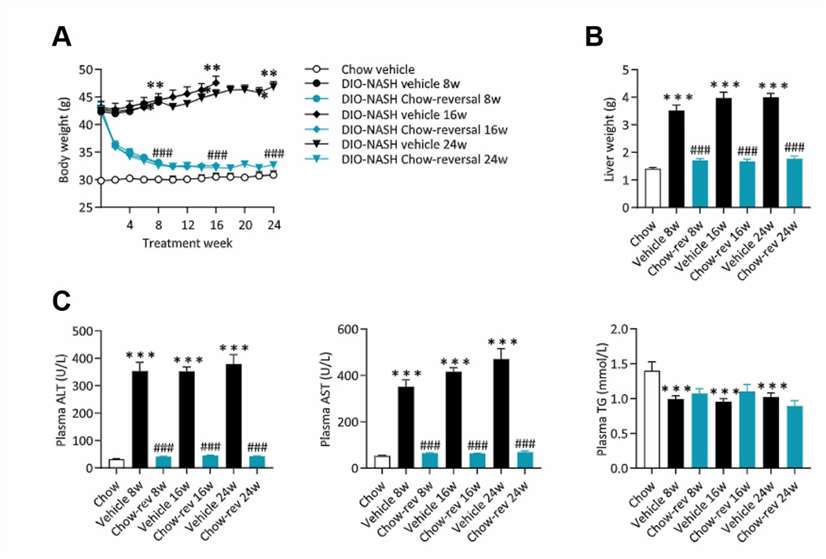Gubra-Amylin NASH (GAN) Diet-Induced Nonalcoholic Fatty Liver Disease (NAFLD) Model
If you are in search of a dependable partner to assist you in evaluating the efficacy of your drug candidates for nonalcoholic fatty liver disease (NAFLD), look no further than Creative Bioarray. We stand out as the premier choice, having successfully established a robust NAFLD model induced by a Gubra Amylin NASH (GAN) diet. Our commitment to excellence is evident in our meticulous approach to model development, ensuring that it accurately reflects the human condition and thereby providing you with the most reliable data for your drug evaluation.
The Gubra Amylin NASH (GAN) diet is meticulously formulated with a specific nutrient composition and caloric density, featuring a 40% high-fat content, 22% high-fructose, and 2% high-cholesterol. This diet has gained widespread recognition and utilization for its efficacy in inducing NAFLD model in animals. By employing the GAN diet, we can effectively study the progression of NAFLD and evaluate the potential of novel therapeutic interventions, thereby contributing to the advancement of treatments for this prevalent condition.
Our Gubra-Amylin NASH (GAN) Diet-Induced Nonalcoholic Fatty Liver Disease (NAFLD) Model
- Available Animal
- C57BL/6 mouse
- Modeling Method
After acclimation, animals are fed GAN diet to induce NAFLD.
- Endpoints
- Body weight
- Liver weight
- Serum analysis: ALT, AST, TG, TC
- Histology analysis: H&E staining, Oil red O staining
- qPCR or Western blot
- Other customized endpoints
Example Data
 Fig. 1 Dietary intervention improves metabolic markers in GAN DIO-NASH mice. (A) Body weight profile and terminal body weight. (B) Terminal liver weight. (C) Plasma and liver biochemistry. Plasma ALT; plasma AST; plasma triglycerides; plasma total cholesterol; liver triglycerides; liver total cholesterol. (Flensted-Jensen et al. 2024)
Fig. 1 Dietary intervention improves metabolic markers in GAN DIO-NASH mice. (A) Body weight profile and terminal body weight. (B) Terminal liver weight. (C) Plasma and liver biochemistry. Plasma ALT; plasma AST; plasma triglycerides; plasma total cholesterol; liver triglycerides; liver total cholesterol. (Flensted-Jensen et al. 2024)
In addition, we also provide other NAFLD models that maybe you are interested in:
- High-fat Diet-Induced Nonalcoholic Fatty Liver Disease (NAFLD) Model
- Methionine and Choline Deficient (MCD) Diet-Induced Nonalcoholic Fatty Liver Disease (NAFLD) Model
- Streptozotocin (STZ) & High-Fat Diet-Induced Nonalcoholic Fatty Liver Disease (NAFLD) Model
Quotation and Ordering
Creative Bioarray is widely recognized as a leading non-clinical Contract Research Organization (CRO) at the forefront of preclinical drug development. Our distinguished reputation is built upon our unwavering commitment to providing you with the most rigorously validated and dependable disease models for the meticulous testing of your compounds. If you are interested in our services, please do not hesitate to contact us at any time or submit an inquiry to us directly.
Reference
- Flensted-Jensen M, Oró D, et al. Dietary intervention reverses molecular markers of hepatocellular senescence in the GAN diet-induced obese and biopsy-confirmed mouse model of NASH. BMC gastroenterology, 2024, 24(1): 59.
For research use only. Not for any other purpose.
Disease Models
- Oncology Models
-
Inflammation & Autoimmune Disease Models
- Rheumatoid Arthritis Models
- Glomerulonephritis Models
- Multiple Sclerosis (MS) Models
- Ocular Inflammation Models
- Sjögren's Syndrome Model
- LPS-induced Acute Lung Injury Model
- Peritonitis Models
- Passive Cutaneous Anaphylaxis Model
- Delayed-Type Hypersensitivity (DTH) Models
- Inflammatory Bowel Disease Models
- Systemic Lupus Erythematosus Animal Models
- Oral Mucositis Model
- Asthma Model
- Sepsis Model
- Psoriasis Model
- Atopic Dermatitis (AD) Model
- Scleroderma Model
- Gouty Arthritis Model
- Carrageenan-Induced Air Pouch Synovitis Model
- Carrageenan-Induced Paw Edema Model
- Experimental Autoimmune Myasthenia Gravis (EAMG) Model
- Graft-versus-host Disease (GvHD) Models
-
Cardiovascular Disease Models
- Surgical Models
- Animal Models of Hypertension
- Venous Thrombosis Model
- Atherosclerosis model
- Cardiac Arrhythmia Model
- Hyperlipoidemia Model
- Doxorubicin-induced Heart Failure Model
- Isoproterenol-induced Heart Failure Model
- Arterial Thrombosis Model
- Pulmonary Arterial Hypertension (PAH) Models
- Heart Failure with Preserved Ejection Fraction (HFpEF) Model
-
Neurological Disease Models
- Alzheimer's Disease Modeling and Assays
- Seizure Models
- Parkinson's Disease Models
- Ischemic Stroke Models
- Acute Spinal Cord Injury (ASCI) Model
- Traumatic Brain Injury (TBI) Model
- Hypoxic-Ischemic Encephalopathy (HIE) Model
- Tourette Syndrome (TS) Model
- Amyotrophic Lateral Sclerosis (ALS) Model
- Huntington's Disease (HD) Model
- Intracerebral hemorrhage (ICH) Models
- Schizophrenia Model
- Pain Models
-
Metabolic Disease Models
- Type 1 Diabetes Mellitus Model
- Type 2 Diabetes Mellitus Model
- Animal Model of Hyperuricemia
-
Nonalcoholic Fatty Liver Disease Model
- High-Fat Diet-Induced Nonalcoholic Fatty Liver Disease (NAFLD) Model
- Methionine and Choline Deficient (MCD) Diet-Induced Nonalcoholic Fatty Liver Disease (NAFLD) Model
- Gubra-Amylin NASH (GAN) Diet-Induced Nonalcoholic Fatty Liver Disease (NAFLD) Model
- Streptozotocin (STZ) Induced Nonalcoholic Fatty Liver Disease (NAFLD) Model
- High Fat Diet-Induced Obesity Model
- Diabetic Foot Ulcer (DFU) Model
- Liver Disease Models
- Rare Disease Models
- Respiratory Disease Models
- Digestive Disease Models
-
Urology Disease Models
- Cisplatin-induced Nephrotoxicity Model
- Unilateral Ureteral Obstruction Model
- 5/6 Nephrectomy Model
- Renal Ischemia-Reperfusion Injury (RIRI) Model
- Diabetic Nephropathy (DN) Models
- Passive Heymann Nephritis (PHN) Model
- Adenine-Induced Chronic Kidney Disease (CKD) Model
- Kidney Stone Model
- Doxorubicin-Induced Nephropathy Model
- Orthotopic Kidney Transplantation Model
- Orthopedic Disease Models
- Ocular Disease Models
- Skin Disease Models
- Infectious Disease Models
- Otology Disease Models